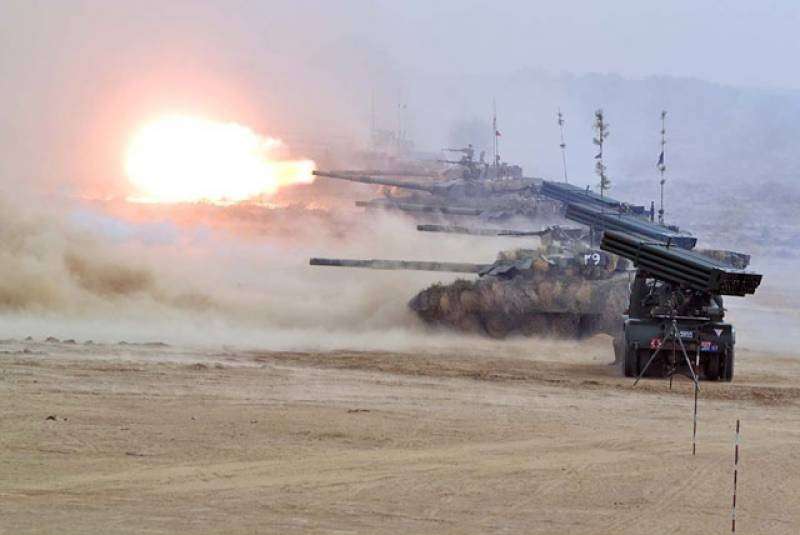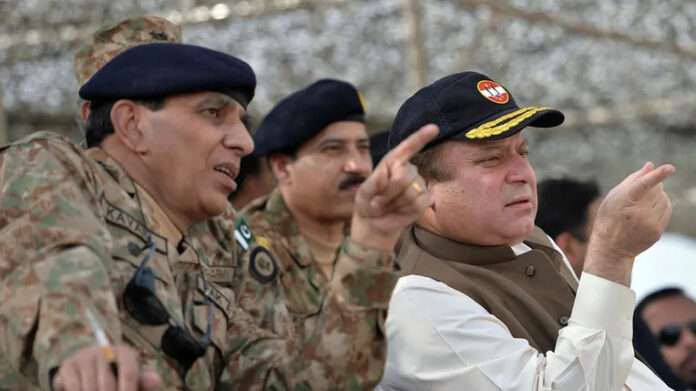Dear Readers,
The “Azm-e-Nau 4” Exercise held at Bahawalpur on Nov 4, 2013 where accurate air and ground based fire power and coordination was on show between the various wings of the armed forces The Pakistan Army’s artillery and soldiers demonstrated the power of defence and attack with anti-tank missiles and short-range weapons while the Pakistan Air Force F-16, JF-17 Thunder and gunship helicopters successfully hit their targets during the drills. Prime Minister Nawaz Sharif alongwith COAS Gen Kayani was there to witness the magnificent live fire exercise that was on display. Also present were the services chiefs, federal ministers. members of the parliament and other distinguished guests. One of the high points of the exercise was the successfully taking down of a drone by targeting it with the 35mm Oerlikon guns by army air defence. Troops from infantry, armoured, artillery, army aviation and air defence also used a variety of platforms to hit their targets. Drones have become quite on emotional issue in Pakistan and public opinion has further become divided with the latest strike by a CIA-operated drone that recently killed Hakimullah Mehsud, the TTP chief. Many politicians have criticized the strike saying it was deliberately carried out to scuttle the peace talks with the Taliban. While addressing the gathering at the exercise the Prime Minister once again stressed that drone strikes constituted a violation of Pakistan’s sovereignty and they were in violation of international humanitarian laws, besides being counter-productive to Pakistan’s efforts for bringing peace and stability in Pakistan and the region.
This exercise marks the culmination of five-year series of such exercises jointly conducted by the Pakistan Army and Pakistan Air Force and aims at validation and crystallization of operational plans prepared in view of the emerging threat environment. For the benefit of readers I am reproducing my article “FIRE AND FORGET”.
The term “fire and forget” denotes a missile which after launching and acquiring a target does not require further guidance, it can destroy the target without the launcher being in the line-of-sight. Precision Guided Munitions (PGMs) hit a specified target minimizing “collateral damage”, military for soft targets eg civilian casualties. The subject of much controversy within Pakistan, drones launch PGMs against militants successfully but do cause civilian casualties, the differing numbers have evoked even more controversy.
Last Monday, Nov 4, 2013, a magnificent live fire exercise was staged at the Tamewali Firing Ranges near Bahawalpur. Conducted by the Army’s 2 Corps, Pakistan Army’s “Mailed Fist” (1 Armoured Division) carried out the ground maneuver complemented by the massed guns of a supporting Artillery Division and Cobra gunships of an Army Aviation combat group. Once the advancing “enemy” was contained and “fixed” in place by an Armour Squadron, the PAF was called into action. In a 12-minute outstanding and display of precision strafing, rocketing and bombing with great accuracy at close quarters, and despite their targets being barely discernible in the smoke, dust and afternoon haze, a range of PAF combat aircraft delivered a lethal combination of munitions, including a PGM launched from an F-16 beyond visual range. Combat pilots flying aircraft at supersonic speeds barely have split seconds to acquire targets and release their munition while simultaneously taking evasive measures against ground fire and anti-aircraft missiles (AAMs).
Having been on the receiving end of intense Indian aerial strafing, rocketing and bombing in Dec 1971 in the Chor Desert, the accuracy of shoulder-fired anti-aircraft missiles was really amazing. On Dec 12, 1971 44 Punjab (now 4 Sindh) commanded by Lt Col (later Brig) Mohammad Taj SJ & Bar led 60 Bde (33 Div) brought post-haste by road, rail and road to Mirpurkhas from concentration area near Rahimyar Khan to relieve the Indian pressure in 55 Bde (18 Div) at Chor and Umerkot without air cove. After the crack of dawn, I lost count of the dozens of Indian aircraft hunting in pairs on the road to Umerkot and then onto Chor. Dropping napalm from time to time, they got only a few vehicles from our entire Bde, in stark contrast to Indian turkey shoot on 18 Div’s tank columns without air cover in the Cholistan desert. The intensity diminished after 2 pm when my unit shot down the second of two Indian aircraft by concentrated machine gun fire. With AAMs nowadays the results would have been much different, on the other hand the lethality of the PGMs at Tamewali gives one more reason to be grateful to God that they were not in use against us in 1971.
Having flown Alouette-3s (besides other rotary and fixed wing aircraft), one knows hovering at “stand-off” position for more than 15 minutes is difficult. Four Cobra gunships engaged their targets with precision and accuracy, speaking volumes for their professionalism and skills. It takes a special breed of men to brave the elements, our helicopter pilots have done tremendous work in Swat and FATA during counter-insurgency operations. Our artillery has always been beyond compare in being precise and committed, the impact of the steady drumbeat of massed artillery fire of an Artillery Division was clearly discernible, accuracy to go with the lethality of the barrage. One would be lucky to survive such concentrated shelling.

The high point was the tank assault by an armoured regiment, what a difference gun stabilization and smooth bore barrels make, with striking improvement in the skills to go with it. Even when stationary, the Sherman tanks supporting us in Chor destroyed enemy machine gun (MG) and Recoilless Rifle (RR) bunkers only after several attempts. Firing with lethal accuracy on the move is a huge game-changer, emulating Mongols riding their horses at full gallop targetting their arrows with accuracy. One of our problems has been “fire control”, the unwritten practice being to “fire at will” covering gaps by crossfire, a thoroughly bankrupt practice. The Army now correctly emphasizes “shoot to kill” i.e. fire for effect.
One major surprise was the presence of Brig Thukral, the Indian Defence Attache (DA), the first time, at least in my memory, of Indian representation at any major Army event. The confidence in making this strong overture of conciliation to India is praiseworthy, will they reciprocate? Brig Thukral witnessed at first hand the lethally of our firepower as well as the professionalism and elan to go with it. The over-riding lesson here, a smaller motivated force with such lethal potential can always contain and even destroy much larger forces. A word of praise for our hosts, Lt Gen Abid Saeed Comd 2 Corps and his men coordinated and executed the entire exercise with superb timing and without incident, truly magnificent!
In April 2010, the culmination of PAF’s Exercise HIGHMARK was a live-fire demonstration at PAF’s Thal Firing Range. The devastating fire drill emphasized how lucky one was to survive the Indian aerial strafing, rocketing and bombing in Dec 1971 in the Thar Desert. However it was really frustrating that sitting in the row in front of me the three stars likely to be Kayani’s replacement as COAS had chests awash with medals but had never been near combat, seeing even this spectacular demonstration from a safe distance. With Kayani soon after getting himself re-appointed as COAS for 3 years (there being no such thing as a 3 years extension), mercifully that became a moot point. In Tamewali the first three COAS contenders were present, thankfully all had combat experience. Kayani has ensured that the army has a richness in the quality of senior officers, professional soldiers of great integrity and character.
Taking over from Gen Musharraf, Kayani was aware that the army’s professionalism had been severely degraded by the military’s involvement in civilian governance. To his credit Kayani went at it systematically, creating task forces, holding discussion and studies, war games, exercises with troops, analysis thereof etc. And all this while the Army has been engaged in extensive counter-insurgency operations. The live-fire culmination of this process of reforming the army (“Azm-e-Nau” Series) is a fitting tribute to Kayani’s retirement ie if the govt does not persuade him to become Chairman JCSC with the expanded powers of promotions/postings of one stars and above.
Former President Zardari never risked visiting an Armed Forces unit as Supreme Commander, let alone one under open skies with live ammunition. The body language of mutual comfort and confidence was on full display when Kayani personally drove Mian Nawaz Sharif to the live-fire exercise podium in an open jeep. Was there anything to indicate the COAS was about to retire barely three weeks later? If indispensable Kayani declines becoming Chairman JCSC, he will likely continue in a civilian capacity as de-facto Defence Minister.
The Tamewali integrated fire drill re-emphasized that the Armed Forces must have coordinated higher defence mechanism, only possible by correcting the anomalies in the chain of uniformed command. Having survived the Musharraf experience, the PM will not have to be “gun-shy” about khaki appointments anymore but “appoint and relax”, paraphrasing (with apologies) the “fire and forget” formula of PGM munitions.




